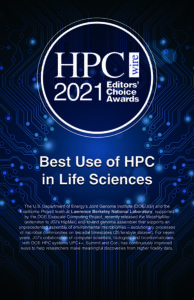This is excerpted from the full announcement “Berkeley Lab Receives Multiple 2021 HPCwire Awards” on the Berkeley Lab Computing Sciences site.
Watch Alicia Clum talk about “MetaHipMer for Terabyte Scale Assemblies” during the recent JGI New Lineages of Life Symposium. Robert Riley also gives a flash talk on “Increasing Taxonomic Diversity of Genome Bins using MetaHipMer for Terabyte Scale Assembly.”
Lawrence Berkeley National Laboratory (Berkeley Lab), the National Energy Research Scientific Computing Center (NERSC), the DOE Joint Genome Institute (JGI), and the Energy Sciences Network (ESnet) have been recognized for outstanding achievements in science, technology, and diversity/inclusion by the annual HPCwire Readers’ and Editors’ Choice Awards. NERSC, JGI, ESnet are U.S. Department of Energy Office of Science user facilities.
The HPCwire Editors Choice Award for Best Use of HPC in Life Sciences went to the Berkeley Lab team comprised of JGI and ExaBiome Project team, supported by the DOE Exascale Computing Project. The award recognized the release of MetaHipMer, an end-to-end genome assembler that supports “an unprecedented assembly of environmental microbiomes.” JGI’s Chief Informatics Officer Kjiersten Fagnan touted the long-standing collaboration between JGI and the ExaBiome team. “They produced fantastic scientific results this year by assembling a collection of large datasets that will enable scientists to explore and collect data in new ways,” she said. “We’re excited to be able to offer this capability to the JGI user community moving forward and to assemble, for the first time these large environmental microbial data sets for JGI users, which include projects looking at wildfire impacts, carbon cycling, and the microbial dynamics in freshwater lakes over a several year period.”

MetaHipMer2 is being used to support a broad array of metagenomics-based user science at the JGI. Left: One of the datasets involves samples from Lake Mendota, a large freshwater lake in Wisconsin. Right: Time series graph with sample dates in the Lake Mendota archive. Filled symbols correspond to dates for which 16S rRNA gene tag data are already available. (Courtesy of the McMahon Lab)
“We’ve been thrilled to see these enormous multi-terabyte datasets assembled for the first time with MetaHipMer, taking advantage of scalable parallel algorithms and GPU acceleration, and we’re preparing for another order of magnitude in scale when running on DOE’s exascale computing systems,” added Kathy Yelick, a professor of electrical engineering and computer science at UC Berkeley and Berkeley Lab scientist who currently leads the ExaBiome project.
Related Publications:
- Hofmeyr S. et al. Terabase-scale metagenome coassembly with MetaHipMer. Sci Rep 10, 10689 (2020). doi:10.1038/s41598-020-67
Related Videos (from 2021 NeLLi New Lineages of Life Seminar):
- Alicia Clum, JGI on “MetaHipMer for Terabyte Scale Assemblies”
- Robert Riley, JGI on “Increasing Taxonomic Diversity of Genome Bins using MetaHipMer for Terabyte Scale Assembly
